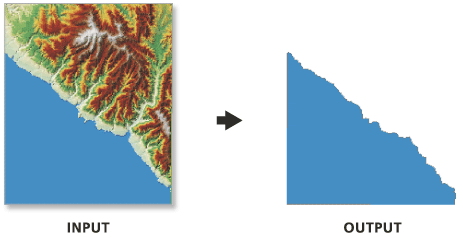Summary
Creates polygon features using tag values in a triangulated irregular network (TIN) dataset.
Illustration

Usage
Tag values can be assigned using an integer field in a polygon feature class by loading the polygon into the TIN as a valuefill surface type.
Triangles that do not have a tag explicitly defined are assigned the default value of 0.
All contiguous triangles with an identical tag value will be stored in a single polygon feature.
The tag value will be denoted as an attribute in the output feature class.
Syntax
TinPolygonTag_3d (in_tin, out_feature_class, {tag_field})| Parameter | Explanation | Data Type |
in_tin | The TIN dataset to process. | TIN Layer |
out_feature_class | The feature class that will be produced by this tool. | Feature Class |
tag_field (Optional) | The name of the field storing the tag attribute in the output feature class. The default field name is Tag_Value. | String |
Code sample
TinPolygonTag example 1 (Python window)
The following sample demonstrates the use of this tool in the Python window.
import arcpy
from arcpy import env
arcpy.CheckOutExtension("3D")
env.workspace = "C:/data"
arcpy.TinPolygonTag_3d("tin", "tin_polytag.shp", "Tag_Value")
TinPolygonTag example 2 (stand-alone script)
The following sample demonstrates the use of this tool in a stand-alone Python script.
'''****************************************************************************
Name: TinPolygonTag Example
Description: This script demonstrates use of the
TinPolygonTag tool to extract tag information
from each TIN in the target workspace.
****************************************************************************'''
# Import system modules
import arcpy
from arcpy import env
import exceptions, sys, traceback
try:
arcpy.CheckOutExtension("3D")
# Set environment settings
env.workspace = "C:/data"
# Set Local Variables
TagField = "Code"
# Create list of TINs
TINList = arcpy.ListDatasets("*", "Tin")
# Verify the presence of TINs in the list
if TINList:
# Iterate through the list of TINs
for dataset in TINList:
# Define the name of the output file
Output = dataset + "_domain.shp"
# Execute TinPolygonTag
arcpy.TinPolygonTag_3d(dataset, Output, TagFieldField)
print "Finished."
else:
print "No TIN files reside in {0}".format(env.workspace)
arcpy.CheckInExtension("3D")
except arcpy.ExecuteError:
print arcpy.GetMessages()
except:
# Get the traceback object
tb = sys.exc_info()[2]
tbinfo = traceback.format_tb(tb)[0]
# Concatenate error information into message string
pymsg = 'PYTHON ERRORS:\nTraceback info:\n{0}\nError Info:\n{1}'\
.format(tbinfo, str(sys.exc_info()[1]))
msgs = 'ArcPy ERRORS:\n {0}\n'.format(arcpy.GetMessages(2))
# Return python error messages for script tool or Python Window
arcpy.AddError(pymsg)
arcpy.AddError(msgs)
Environments
Licensing information
- ArcGIS for Desktop Basic: Requires 3D Analyst
- ArcGIS for Desktop Standard: Requires 3D Analyst
- ArcGIS for Desktop Advanced: Requires 3D Analyst